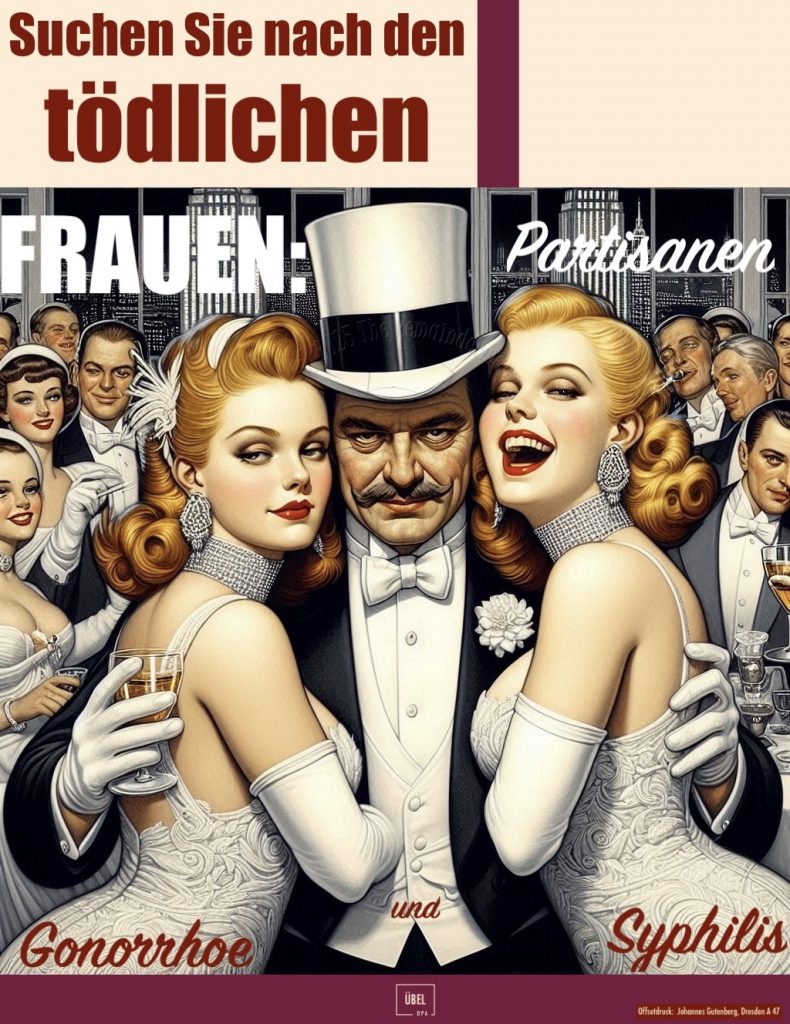
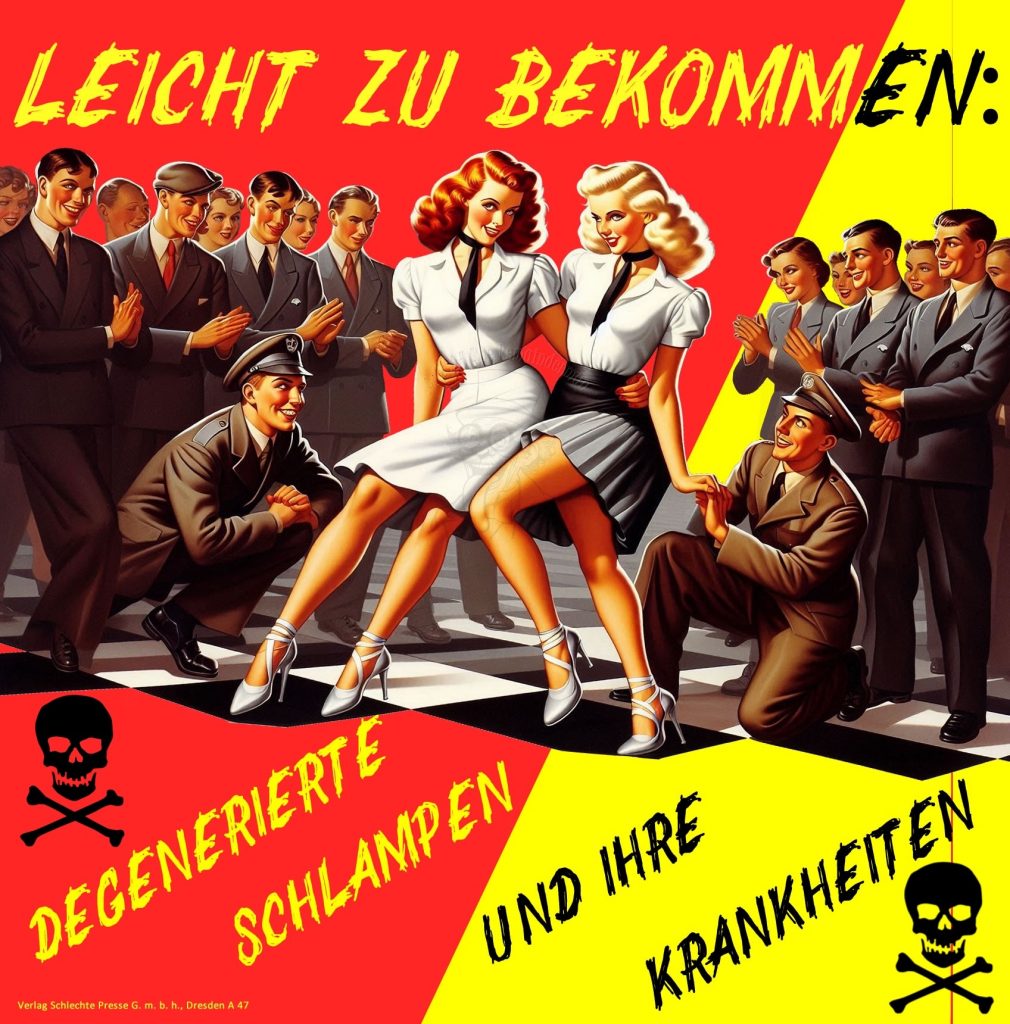
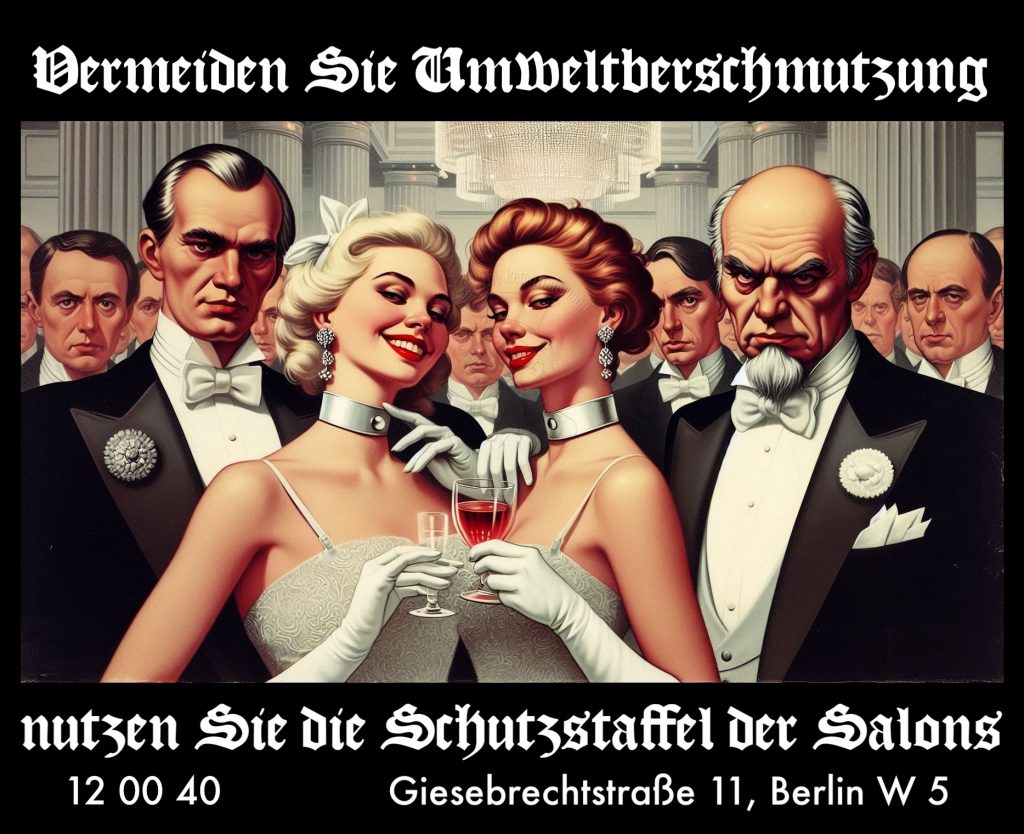
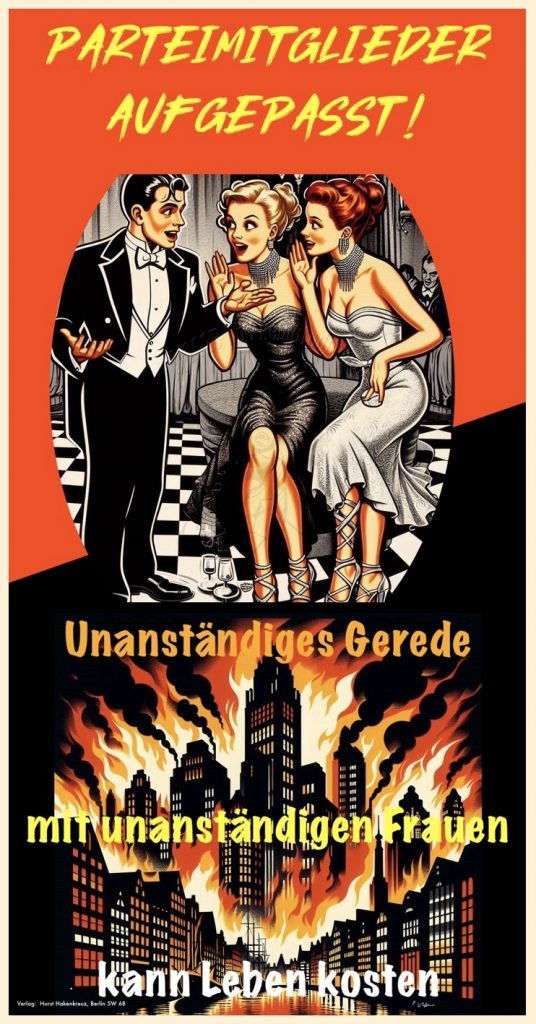
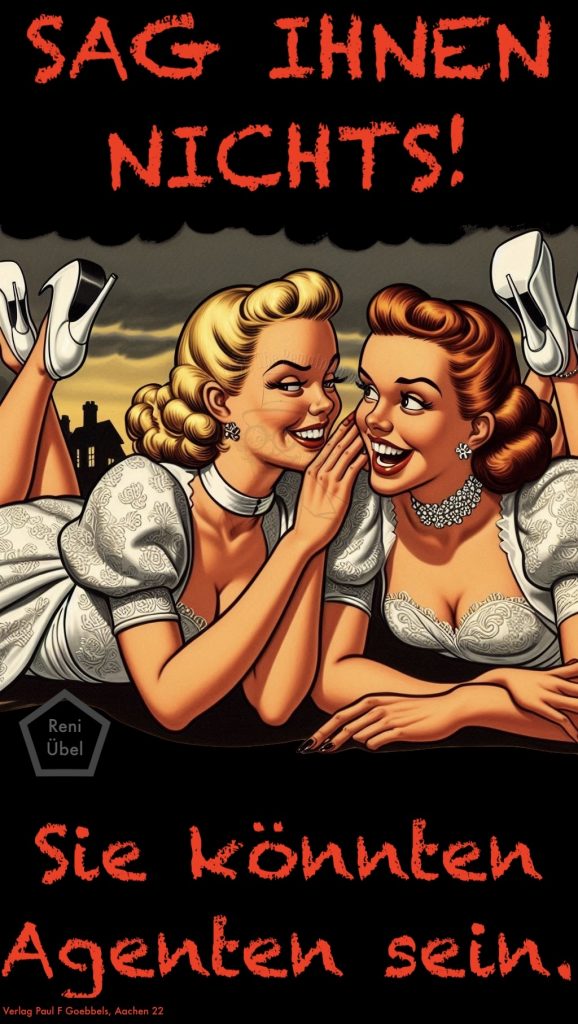
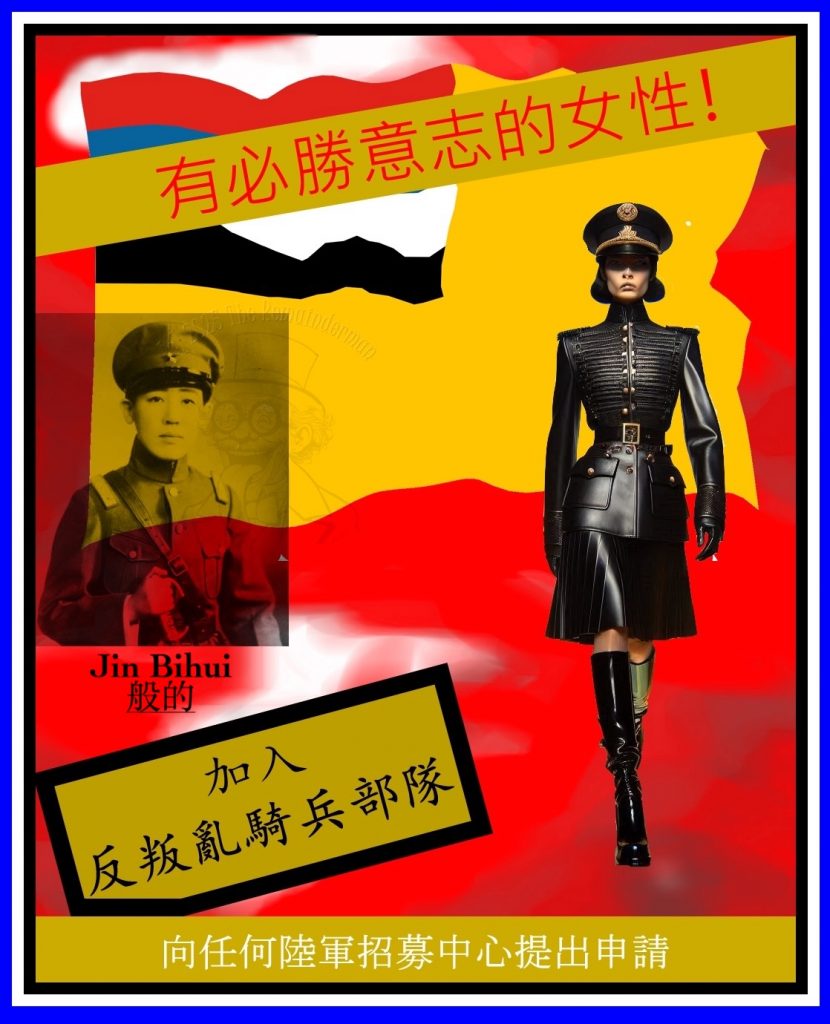
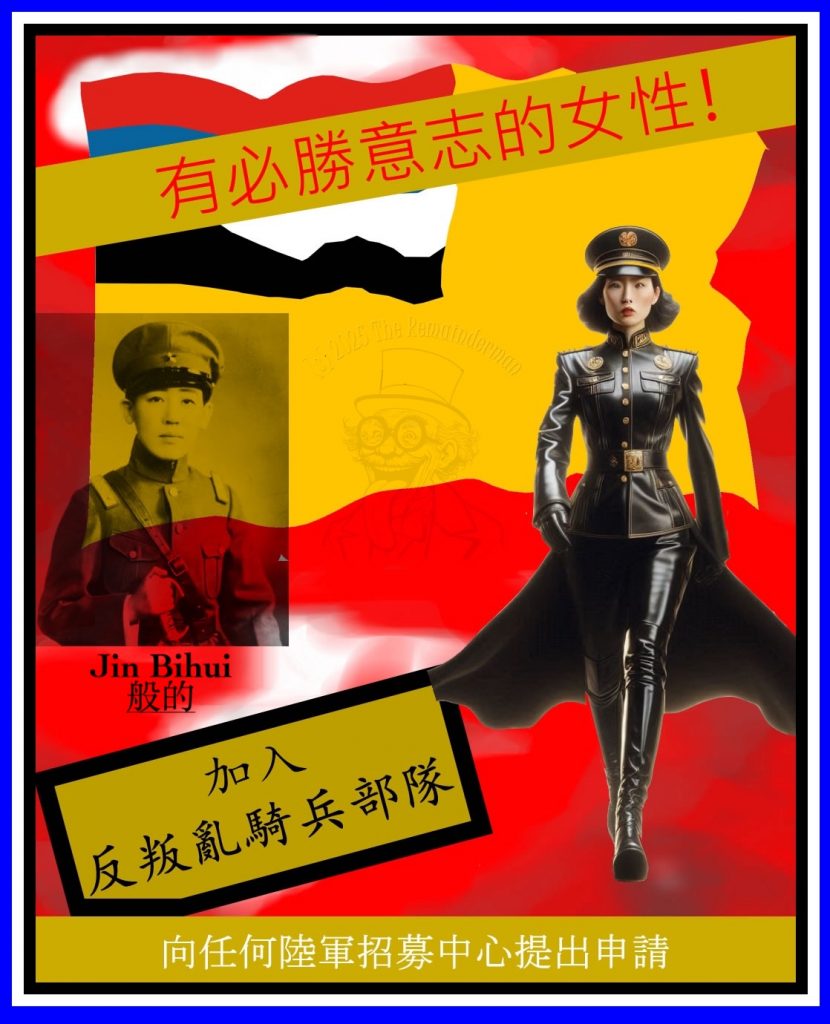
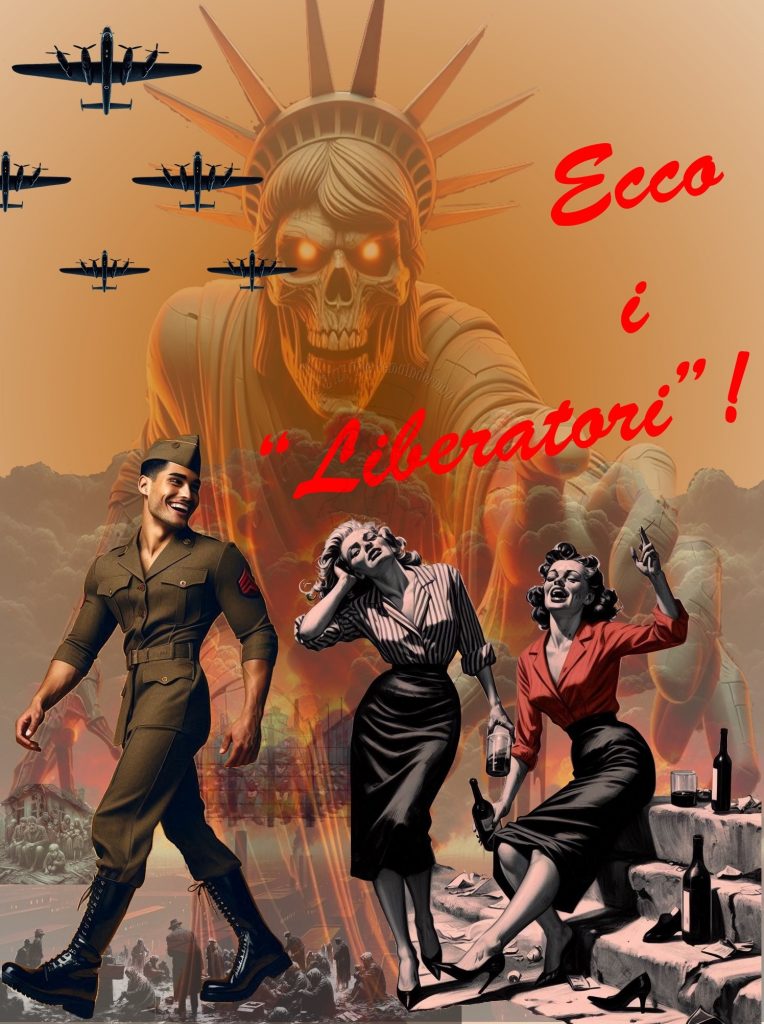
These images arose out of a desire to show adult Penny and Chas acting in roles similar to their roles as operatives of Channah in ARP, namely, spies and saboteurs. Since I wanted them to be acting for the Western Allies, they would have to be portrayed as a risk warned against in Axis propaganda.
As the project expanded, the posters became a way to comment on the narrow roles Axis ideologies prescribed for women—and the hypocrisy shown, especially as the war wore on, in their treatment and use of women. Even the Nazis, from the very start, when faced with defiance by some strong women, celebrated them for their achievements in areas outside the home. Notable examples (listed not to apologize for them, but to criticize fascist ideology) include one of the most-important propagandists on behalf of the Nazi regime, Leni Riefenstahl; women who used their celebrity in nontraditional roles to support the Nazis such as Hanna Reitsch; and Yoshiko Kawashima (identified in images 1932 and 1934 by her Chinese name, Jin Bihui), a tragic figure victimized from a young age and deeply conflicted about her own sexual and ethnic identity who burned a fiercely unconventional arc through the Japanese occupation of China ending in her execution for treason.
By the end of the war, hundreds of thousands of German women had been trained in military schools and were serving for all intents and purposes as soldiers of the regime, in dangerous battlefield jobs, most of them performing air-defense and fire-fighting missions during air raids while Allied bombs were falling all around them and Allied fighters, virtually unchallenged in the air, could focus on suppressing air defense. Yet I found only one example of a recruitment poster showing a woman wearing a helmet, and only a couple with women in uniform, at a time when uniforms were ubiquitous in German society, worn by civil servants and military personnel alike in a fully-mobilized economy.
Their own country refused to call them soldiers, asserting that they were merely civilian “helpers,” despite the fact that by the end of the war, their formations and positions appeared on Wehrmacht organizational charts and their uniforms displayed military, or more-sinister (i.e., SS), insignia. Which points to a complication in understanding their position in Nazi society: After the war, German men and women alike, especially those “helping” the SS, had every incentive to, and in fact fell all over themselves to, deny women had been in the SS (which was declared a criminal organization) or the military (which was deeply implicated in crimes of the regime).
Nonetheless, it seems clear that the Nazis were unwilling to admit they needed women’s help outside the home as well as inside it, to fight their war; or even that women were capable of doing the jobs they were actively recruited, and eventually drafted, to perform (and that they did, in fact, perform), because to do so would have meant admitting shortcomings in their own ideologies and propaganda. There is much less information available, at least in English, or that can be found using English-language searches, about Nazi Germany than Fascist Italy, or even more, Imperial Japan. Accessible portrayals of women in Japanese wartime propaganda were few and far between, and those I did find weren’t accompanied by text I could cut and paste into Google Translate, or retype on my keyboard. But totalitarian regimes and newly-emergent industrial economies tend to be socially conservative, and what I was able to find suggested very conservative and limited roles were prescribed for women.
Axis ideology did not allow women to be heroic figures. It did not even allow them to be dangerous, nefarious, or even sexualized ones. Thus, even in propaganda reminding people not to discuss or reveal sensitive military information, which were ubiquitous across all combatants, Axis posters rarely identified nefarious or seductive women as the threat.
Posters of the Western Allies (Soviet patterns sometimes allowed or required women to be heroic but didn’t offer them much agency or sexuality) were another matter. If anything, as suggested already in relation to Allied Recruitment posters (subsection 07-04-F), women were often portrayed as conniving, traitorous, diseased sluts constituting a threat to the war effort and to decent servicemen. Women featured prominently as antagonists in Western Allied campaigns warning against loose talk; and almost inevitably, were the primary villains in campaigns warning against venereal disease. These campaigns were prominent and widespread, with some reason; venereal disease had become a significant source of manpower shortages in World War One, and the US in particular from the very start went to war with a vengeance against VD. The results, helped by medical improvements, were notable: infections among US servicemen in World War Two were possibly as low as 3% of those a generation before when the total number of mobilized men had been lower. But to a significant extent, the campaigns focused not on the logic and mathematics of infection, or on the diseases themselves, but on the (mainly female) agents of transmission.
For purposes of these images, I used propaganda posters produced by the Western Allies as the starting points for made-up Axis ones that the Axis powers would have been unlikely to produce.
Literature Section “07-04-G Axis Portrayals of Women”—Accompanying Images: 1688-1692, 1932, 1934, 1946A; 1688U, 1690U, 1933, 1946B&U—Published 2025-06-17 to 06-23—©2025 The Remainderman. This is a work of fiction, not a book of suggestions. It’s filled with fantasies, idiots, and criminals. Don’t believe them or imitate them.
1688 07-04 Look for the deadly women: Partisans, Gonorrhea and Syphilis (ABRIDGED version)—UNABRIDGED VERSION INCLUDING FASCIST IMAGERY AVAILABLE AT PATREON.COM/THEREMAINDERMAN. 2025-06-17; Penance & Chastity; propaganda poster; compare numerous examples at https://cvltnation.com/crazy-venereal-disease-posters-from-wwii/. Translation (German to English): Suchen Sie nach den tödlichen Frauen: Partisanen, Gonorrhoe und Syphilis Look for the deadly women: Partisans, Gonorrhea and Syphilis. The linkage between “good-time girls,” “loose women,” “prostitutes,” “pick-ups,” “bags of trouble,” etc., and diseases in numerous posters was thoroughly spelled out for slower servicemembers. The broadest categorization, and the closest to bluntly suggesting all women are whores, that I saw, which also offered some spurious pseudo-scientific statistics, was the poster cautioning “98% of procurable women have venereal disease.” Alternatively, that could be interpreted as insulting servicemen, e.g.: “98% of the women available to losers like you are diseased….” An implication more narrowly targeted against women suggested “Amateurs” are just as dangerous as prostitutes. I included partisans because actual German posters addressed them as menaces, including at least one instance where as I recall, they portrayed a female as a partisan. I originally made the unabridged version thinking nothing of it, then realized it could create a risk of being removed and had nothing really to replace it.
1689 07-04 Easy to get… Degenerate sluts and their diseases—2025-06-18; Penance & Chastity; propaganda poster; compare https://artpictures.club/autumn-2023.html specifically, and other posters generally, at https://cvltnation.com/crazy-venereal-disease-posters-from-wwii/. Translation (German to English): Leicht zu bekommen: Degenerierte Schlampen und ihre Krankheiten Easy to get… Degenerate sluts and their diseases. There were at least two versions of this poster during World War Two. The comparison of prostitutes to their diseases was made visually by the original images in both versions. I just spelled out the comparison between human beings, viruses, and bacteria more explicitly here.
1690 07-04 Avoid Pollution–Use Protection Squad Salons (ABRIDGED version)—UNABRIDGED VERSION INCLUDING FASCIST IMAGERY AVAILABLE AT PATREON.COM/THEREMAINDERMAN. 2025-06-19; Chastity & Penance; advertisement; Translation (German to English): Vermeiden Sie Umweltverschmutzung – nutzen Sie die Schutzstaffel der Salons Avoid Pollution–Use Protection Squad Salons. There is no specific historical example behind this poster; the anti-VD advertising campaign was Allied, and the Allies (to my knowledge) didn’t operate any brothels like the SS, Wehrmacht, and Imperial Japanese Army (although the Japanese administration under American occupation after the war did operate official brothels for a time). The address is the actual address of Salon Kitty, a high-end brothel that was taken over by the Sicherheitsdienst (SS Security Service) for spying on Germans and foreigners of interest (and is actually not representative of the official, overt forced-labor brothels run for German military, SS, and kapo personnel since it was a clandestine operation). The phone number in the abridged version is that of the Reichsführer-SS’s (Himmler’s) office according to the 1941 Berlin phone book (only a limited number of entries from it were available and legible online).
1691 07-04 PARTY MEMBERS BEWARE! Loose talk to loose women can cost lives—2025-06-20; Chastity, Penance; motivational poster; compare https://www.worthpoint.com/worthopedia/original-john-falter-wwii-poster-458626456, for the Allied anti-loose-talk poster that was the departure point design- and slogan-wise. More broadly, see the Allied posters warning about loose women at https://cvltnation.com/crazy-venereal-disease-posters-from-wwii/ and https://www.cnn.com/2015/08/25/health/wwii-vd-posters-penis-propaganda/index.html, further discussed above. Translation (German to English): Parteimitglieder Aufgepasst (vorsicht)! Party members, pay attention (beware)!; Unanständige(s) Gerede (Gespräche) mit unanständigen Frauen kann (können) Leben kosten Indecent (loose) talk with indecent (loose) women can cost lives. The original is targeted at sailors but because of challenges with the AI (discussed elsewhere), this one is targeted at a category of people who theoretically could be in civilian clothes since I could not generate any suitable images for this with uniformed Germans. Google changed translations on me when I double-checked before publication from German back to English; the translations shown are based on the final re-check with variations to illustrate how words varied based on the original English and English translations of the later German.
1692 07-04 TELL THEM NOTHING! They might be agents—2025-06-21; Chastity, Penance; motivational poster; compare https://rarehistoricalphotos.com/american-propaganda-posters-world-war-two/. Translation (German to English): Sag ihnen nichts! Tell them nothing!; Sie könnten Agenten sein They might be agents. I counted it as a win that I was able to get the girls on their stomachs. The AI really does not like being told how to position people, especially women. I really like the faces and expressions here, which seem at once girlish and sinister. Unlike 1945, which I was able to double-check with an Italian pronoun guide online, I didn’t find a way online to double-check whether the German would be different for a female vs a male or mixed “them”; any input on this point would be appreciated.
1932 & 1934 07-04 Join the CCF-Women with a will to Win-Apply at any Army Recruiting Centre—UNABRIDGED GERMAN COUNTERPART INCLUDING FASCIST IMAGERY AVAILABLE AT PATREON.COM/THEREMAINDERMAN. 2025-06-22; Fang; recruiting poster; compare: https://www.alamy.com/vintage-ww2-recruitment-poster-with-female-ats-member-in-uniform-union-jack-flag-flies-behind-women-with-a-will-to-win!-join-the-ats-apply-at-any-army-recruiting-centre-1939-1945-image342804140.html?imageid=16439DED-FF10-4602-991A-74F85C0BBF85&p=66052&pn=1&searchId=eecbd4edf63c33347e7f7b028a6f8218&searchtype=0; Translation (Mandarin to English) 有必勝意志的女性! Women with a will to Win!; 般的 General Jin Bihui; 加入 Join the; 反叛亂騎兵部隊 counterinsurgency cavalry force; 向任何陸軍招募中心提出申請 Apply at any Army Recruiting Center. Any feedback on the technical aspects of this poster would be much appreciated. The poster is in Chinese but I’m not even sure, if there had been such a recruiting poster, whether the proper language would have been Chinese, Manchu, or even Japanese. The “counterinsurgency cavalry force” is the irregular formation raised by the Qing dynasty princess who was adopted (abused) and raised in Japan and later became associated with the Manchukuo puppet regime (it is her photograph above her name, Jin Bihui, in a Manchukuo army uniform). I am not sure if the force had an official name; or if it did, whether it was actually that, or if “counterinsurgency cavalry force” is a descriptive reference. Being that it was a cavalry force and she was a Manchu, perhaps the most obvious pool for her to recruit from would have been Manchus. By the time of World War II, however, I understand Manchuria had been heavily Sinicized. Because the poster is in Chinese I used her Chinese name, Jin Bihui. I’m pretty sure, but not entirely, that I have the correct Chinese-character transliteration of that name; but in addition to having formatting issues with it, and the lingering uncertainty, I did hope by including one bit of Latinized text with the only specific name I included in the poster (it doesn’t even use the word “Manchukuo” in the text) that people who didn’t notice this description could find relevant historical information about the poster online. I made two versions, one for the year the puppet regime was created and the other for the year it was renamed Manchukuo and made nominally imperial, because what can I say: I like Fang in black leather. These posters came about because, having seen Channah in leather and thinking of poster 1933, it seemed only right that the leather-armor-clad Fang should have a poster of her own on the evil side of the fence.
1946 07-04 Here are the “Liberators”! (ABRIDGED version)—UNABRIDGED AND BONUS VERSIONS INCLUDING FASCIST IMAGERY AVAILABLE AT PATREON.COM/THEREMAINDERMAN. 2025-06-23; Miryam, Rivqah, Lancelot; propaganda poster; compare https://www.alamy.com/stock-photo-italian-world-war-ii-poster-here-are-the-liberators%60-shows-the-statue-57365951.html. Translation (Italian to English): Ecco I “Liberatori”! Here are the “Liberators”! The original poster chilled me, partly because it reminded me of the Norwegian fascist poster (widely used by the Germans) “Liberators,” and partly on its own account, and its description by one source online as an “angel of death” version of the Statue of Liberty. As an American, it creeps me out to see American icons toppled and reversed that way, especially in this day and age; and especially when—by alluding to Allied bombing campaigns in the Italian example, and half-a-dozen ways in the “Liberators” poster, they manage to capture a kernel of truth about America’s own moral challenges. In some ways, I imagine this to be the worst nightmare within the ideology of Axis propaganda because it depicts women from fascist countries not just as victims (as in poster 1945), but as collaborating or cooperating with the Allied conquerors, perhaps even with a bold spirit of determination to survive in difficult circumstances where the roles assigned to them by Axis ideologies are no longer enforced, and the men they were supposed to rely on for protection have been defeated in a war of their own making. Of course, there were German and Italian prostitutes during the WW2 era; but the German and Japanese policy of forced-labor brothels very much reinforced and followed their racist ideologies by making women from occupied countries service their troops. Racially-ambiguous Lancelot allows but does not require the viewer to add a racial dimension to the poster, although as noted with respect to 1945, doing so would be entirely consistent with Italian wartime propaganda.